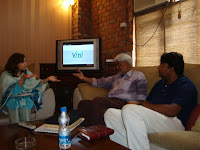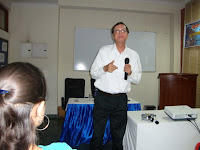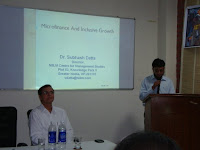










Micro Finance can be one of the sustainable solutions to the gross roots financial problems, if is done through participatory manners and with an effective financial system in place articulated by Dr. Subhash Datta Director, NIILM Centre for Management Studies at International Business School - Meadows (IBSM) in Delhi during his session on providing urban amenities in rural areas. He delivered his presentation through a very interactive session that included some important pieces to mention.
Mr. Datta said that, many different types of methodologies were used for sustainable development of developing countries such as, land reforms, food security, basic minimum needs of people, growth centre theory area approach and infrastructure development but these methods have had very limited success
It has long been recognized that the problems can be resolved by the methodologies of Management Science.
He further added that development is a process that ensures utilisation of the resources of a country including manpower resources to increase the economic growth and advancement of the welfare of the community as a whole - essential condition of this process is a fair and equitable distribution of gains of economic growth.
During Dr. Datta’s session some following concepts were also came into discussion among speaker and the participants.
Participation:
Meaningful participation presupposes that participants understand various aspects involved in the suggested development strategy, only then they can suggest constructive modifications. This process in actual practice was significantly improved through GIS based computerized maps. These maps are used o clear participants’ doubts and answer their queries. Looking at the impact of alternative strategies in the maps, they were able to understand the implications better.
Participatory process helped the following:
Creation of awareness of the issues related to development sector, generation of participative evaluation of technological feasibilities of improving productivity of land and optimizing the use of resources, ceation of awareness of need for sustainability and understanding the utility of assessing land, water, bio-mass / energy balance etc.
The next step in the participation process was concerned with understanding of sustainability, external inputs required to attain and maintain a specific level of primary productivity should decrease over the long term, to achieve the above, nutrient balance should be maintained by progressive improvement in the recycling of all kind resources and waste and sustainability also implies that the external energy required to maintain the target level of production and quality of services do not unduly increase in the long run.
The participants of the workshop concluded the session on the following aspects:
The possibility of future transformation of the society through continuous interactions and result oriented methodologies based on connectivity
Once the common people see the benefits in terms of more production, distribution and employment potentials they have no hesitations in implementing the required changes.
Soon after tea break, the second session was led by Mr. Arshad Jamal (Senior Manager) Alkhair Foundation India.
Mr. Jamal explained the Microfinance and how micro credit works:
Microfinance is the provision of financial services to those who are excluded from conventional commercial financial services since most are too poor to offer much or anything - in the way of collateral. It presents a series of exciting possibilities for extending markets, reducing poverty and fostering social change.
The concept of microfinance originated in the mid-1970s in Bangladesh through a pioneering experiment by Dr Muhammad Yunus, then a Professor of Economics. His aim was to offer poor people:
• financial services
• entrepreneurship opportunities
• an end to mistreatment by money lenders
• a system where they could produce, manage and maintain their own finances
The most common form of microfinance is micro credit - the extension of small loans to entrepreneurs too poor to qualify for conventional bank loans. This is where the Micro Loan Foundation comes in.
Microfinance and micro credit have two distinct advantages over charitable giving. Firstly, it is sustainable and creates independence from aid, not dependence on it. By giving a small loan to an individual, it is hoped that it would give ability to poor to work their own way out of poverty. Micro Loan lends to groups of about 10 to 15 women, allowing individuals to support, encourage, and provide assistance to each other if things go wrong.
Secondly, it means that the money goes directly to the people who need it - bypassing the bureaucracy and corruption that can compromise traditional methods of charitable giving.
Moreover, MicroLoan never lends to individuals without first providing them with the expertise and training to build a business plan that is likely to succeed.
Mr. Jamal concluded his session having taken the reactions of participants then the day concluded with next day’s assignment.
The other part of training aligned with an exposure visit of Indian market place called, Select City Walk Mall, Saket, New Dehli.
The brief findings regarding team’s visit to Select City Walk mall are:
• The mall was really an amazing business initiative of an Indian Government as it has every thing to buy under one roof, but it seems that poor are out of the scene as the whole mall caters to the needs who afford heavy price of goods.
• The imported items were available for sale except china products, it is not worth buying china things because all of them are merely imitation; hence people don’t like things made by China.
• The frequency of foreigners from different countries to this mall was a common thing, upon a question from one of the foreigners ,that how he is feeling to be in India, he replied without having second thought that, India is a peaceful country and the democracy is quite stable here which allows tourism at great length.
• The shopping/pole thane bags in India are prohibited owing to its hazardous effects over the health of all living beings. The alternative source of shopping bags is now having a very thin rather stable fabric bags are commonly used to shop.
The team came back to camps before 9:30pm and had quick debriefing session.
No comments:
Post a Comment